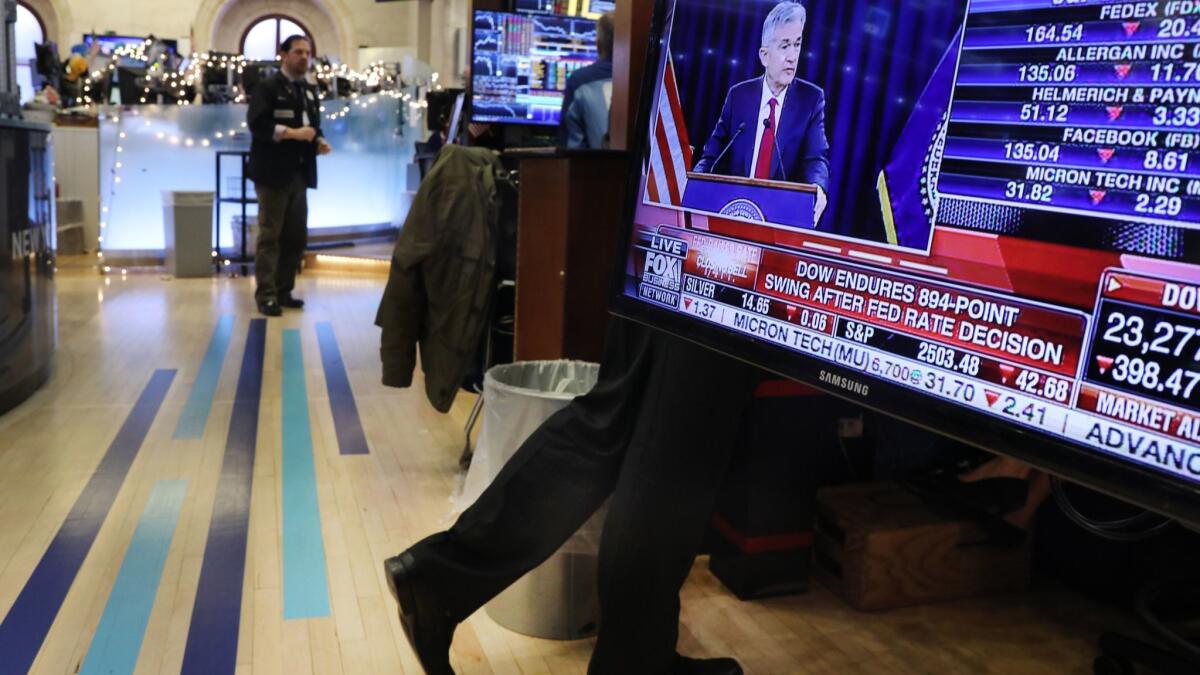Bonds may be back as your best hedge against stock market doom

- Share via
Reports of the death of bonds as a hedge against stock nightmares have been greatly exaggerated.
In the recent equity sell-off, U.S. Treasurys resurged with a vengeance, bringing with them the decisive return of a relationship investors have counted on for decades: When stocks go down, bonds tend to go up and vice versa.
BlackRock Inc. says it’s once again a good idea to have Treasurys in a portfolio, while the likes of HSBC Private Bank, JPMorgan Asset Management and Wells Fargo Asset Management also tout fixed-income securities as a shelter from stormy stocks, whose volatility last month jumped to a 10-month high.
The inverse correlation between stocks and bonds has underpinned the favorite and most simple diversification strategy of fund managers across the globe — until last year when both markets fell together, a two-decade rarity.
“While the relationship can change on any given day or over any given week, until we get closer to the end of the Fed’s [interest rate] hiking cycle, we think the relationship is one that will continue to play out,” said Brian Jacobsen, a senior investment strategist at Wells Fargo Asset Management, which oversees about $500 billion in assets.
Tighter monetary policy, U.S. government borrowing in overdrive and inflationary fears lifted yields last year — bond yields move in the opposite direction as prices — raising the specter of a regime shift unkind to the traditional equity-bond dynamic.
Diversification just changes the trade-offs investors face. In hindsight, those trade-offs could be like trading a slap in the face for a punch in the gut.
— Brian Jacobsen, Wells Fargo Asset Management
Treasurys are proving their value once more as fundamentals crater, with the latest rout in stocks driven by fear of a global slowdown that has prompted traders to scale back expectations for rate hikes — a buy signal for Treasurys.
That’s a far cry from sell-offs in the second half of last year, where interest-rate fears weighed on both stocks and bonds, according to Willem Sels, chief market strategist at HSBC Private Bank.
“The return of negative correlations is good news, as diversification was hard to achieve in 2018,” said Sels, who’s gravitating toward havens and hedges. He’s overweight gold, likes quality stocks and is sticking to shorter-term bonds that are less sensitive to changes in interest rates.
Thushka Maharaj, a global multi-asset strategist at JPMorgan Asset Management, says the late-cycle dynamic — monetary tightening in response to inflationary pressures — tends to challenge the vanilla bond-equity link. But it ultimately proves self-stabilizing thanks to policy redress.
Indeed, after the December plunge in U.S. stocks, Fed Chairman Jerome H. Powell said central bank policy was flexible and officials were “listening carefully” to financial markets.
“In the current inflation-targeting regime where central banks are credible, we find it hard to see prolonged periods where inflationary concerns make returns in both stocks and bonds negative at the same time,” Maharaj said by email. “A key view we hold is that bonds act as a diversifier in the event of negative growth shocks and the negative stock-bond correlations will reassert in growth slowdown scares or recession fears.”
In a low-return world, there are plenty of reasons to fret the fortunes of traditional 60/40 portfolios — 60% stocks and 40% bonds — but the prospect of bonds losing their hedging firepower could prove the last straw.
With stocks forecast to post paltry gains and bonds expected to generate not much more than their coupons this year, Christophe Donay at Banque Pictet & Cie has turned to other hunting grounds — namely real estate and private equity.
“This is the first time in my career that I have seen such a breakdown of correlations between bonds and stocks,” said Donay, the head of asset allocation and macroeconomic research at Pictet, whose career has spanned three decades. “We decided to diversify to illiquid assets because of the poor returns in bonds and stocks.”
So-called “endowment style” investing — designating one-third each to stocks and bonds, and another third to illiquid assets — is supplanting 60/40 in many of his funds, he said.
Wells Fargo’s Jacobsen remains a believer in diversification. A balanced portfolio may have lost money last year, but less than if investors had put everything into equities.
After suffering its worst year in a decade, DFA’s Global Allocation 60/40 Portfolio is bouncing back and reversed course in late December.
“Diversification just changes the trade-offs investors face,” Jacobsen said. “In hindsight, those trade-offs could be like trading a slap in the face for a punch in the gut.”
More to Read
Inside the business of entertainment
The Wide Shot brings you news, analysis and insights on everything from streaming wars to production — and what it all means for the future.
You may occasionally receive promotional content from the Los Angeles Times.










